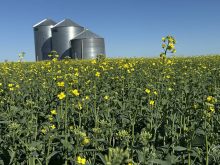Producers are not alone as they search for a bigger bang from their farming buck. Prairie researchers are trying to lend them a hand by developing high-efficiency farming methods.
“I look for win-win solutions that allow farmers to make more efficient use of nutrients,” says Don Flaten, a soil scientist with the University of Manitoba.
“In most cases it will help their bottom line. My motivation is to help farmers adapt to these challenges.”
Farmers might not have a choice. Energy and petroleum prices are escalating, which means the price of fertilizer, fuel and other farm inputs
Read Also

Huge Black Sea flax crop to provide stiff competition
Russia and Kazakhstan harvested huge flax crops and will be providing stiff competition in China and the EU.
has also increased.
As well, governments are beginning to move against causes of water pollution and often target farming methods and fertilizers as the prime culprit.
Cynthia Grant, an Agriculture Canada researcher in Brandon and one of the world’s leading nutrient efficiency experts, said farmers have a vested interest in using nutrients correctly.
“You want to make sure the nutrient gets into the crop, not the water,” Grant said.
“If you’re using the input efficiently, you’re often reducing the environmental impact.”
Much of modern agriculture is based on the heavy use of energy. Most nitrogen fertilizer is created from natural gas, and multiple field operations are required for producing most crops. With oil prices hovering near $100 per barrel, that reliance is worrying, especially if inputs are being wasted.
“You don’t want to throw it away at $650 a tonne,” Grant said.
Worldwide, high fuel prices threaten crop production profitability, which Flaten said in turn threatens world food supplies.
“Nearly half the world derives its food from agricultural systems using natural gas to produce nitrogen fertilizer. That’s an amazing statistic.”
To stay ahead of stampeding energy and input prices, researchers such as Grant and Flaten are attempting to find ways to increase the uptake of nutrients by crops, something farmers have already taken seriously.
Since the evolution of conservation tillage farmers have been banding their nitrogen, making its uptake much more efficient. And years of research have shown farmers how to farm without tilling and yet still control weeds.
Flaten said he hopes a similar revolution is possible with nutrient efficiency because that has had great gains for farmers.
“The adoption of conservation tillage across Western Canada was one of those fantastic, collaborative things,” Flaten said.
However, he doesn’t expect it to be so exciting. Instead of leading to the creation of big new machines and radically different looking fields, a nutrient efficiency revolution will take place quietly, in the soil, as farmers understand how to operate a holistic system.
Grant said the gains will also come slower because the biggest efficiency gainer – fertilizer banding – has already been mostly achieved.
“All the easy things have been done,” she said.
“We’re looking at incremental movements from here.”

















